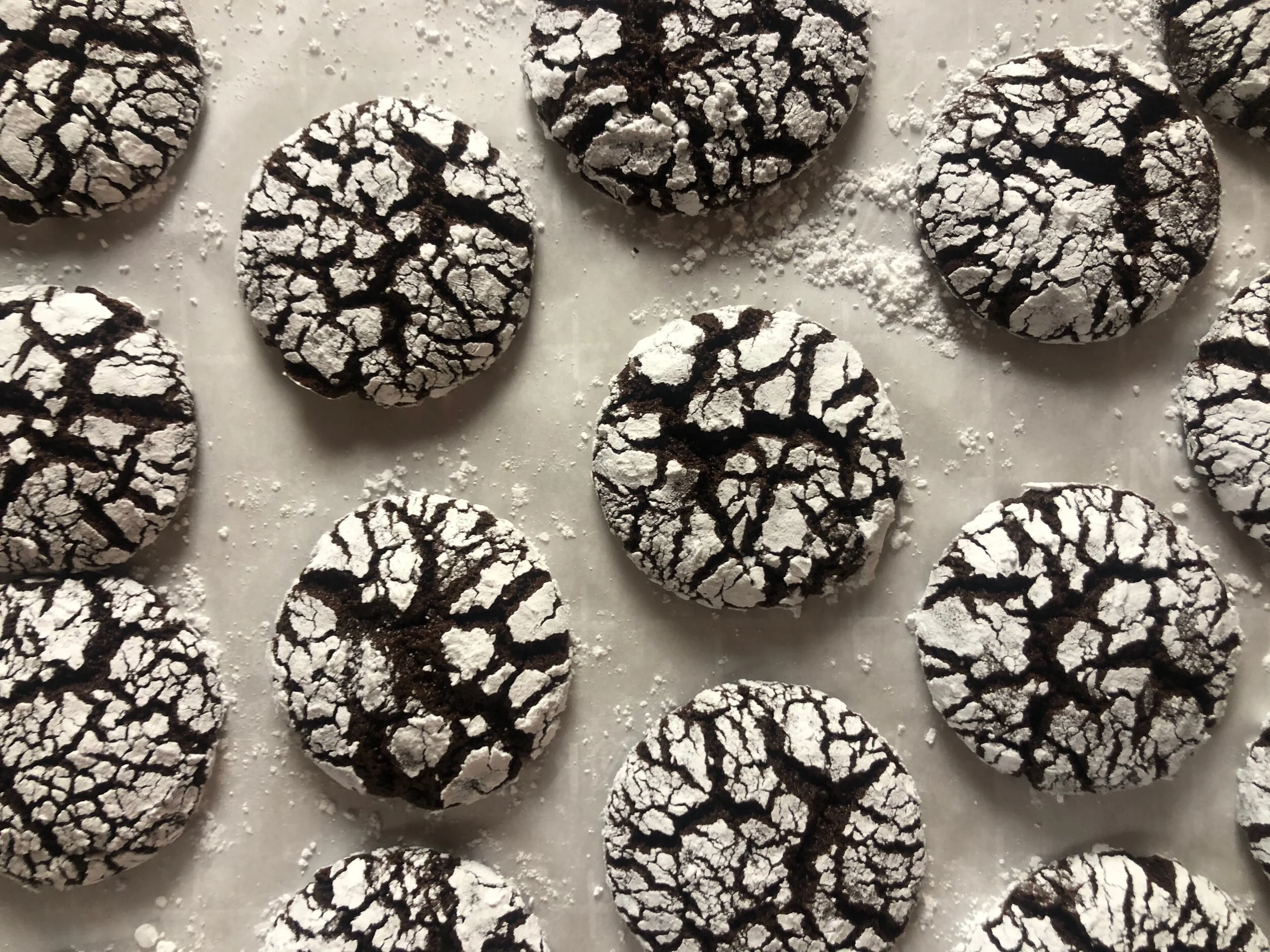Chocolate Peppermint Crinkle Cookies
Chocolate Peppermint Crinkle Cookies
Make about 24 (1.5-inch cookies)
Ingredients:
2 ounces unsweetened chocolate (100% cacao), finely chopped (about 1/3 cup)
2 tablespoons unsalted butter, cut into small pieces
1/2 cup all-purpose flour
1/4 cup Dutch process cocoa powder
1/2 teaspoon baking powder
1/4 teaspoon fine salt
1/8 teaspoon baking soda
1/4 cup crushed peppermint candy canes (about 5 large candy canes) NOTE: If you don’t like peppermint, use 1/4 cup chocolate chips instead)
1 egg
1 egg yolk
3/4 cup packed dark (or light) brown sugar
1/2 teaspoon vanilla extract
1/3 cup confectioner’s sugar
1/4 cup granulated sugar
Steps:
1. Adjust an oven rack to the middle position of the oven. Heat oven to 350°F.
2. Line a baking sheet with parchment paper or a Silpat (or even foil).
3. To melt the chocolate and butter: finely chop the chocolate on a cutting board, or place it in a small sealable plastic bag and bang it until finely broken with a rolling pin or mallet. Transfer chopped chocolate to a small microwave-safe bowl, along with the butter.
4. Place bowl in the microwave and heat at 50% power for 1 minute. Stir, and continue to heat at 50% power until melted, about 1-minute more. (If you cannot reduce the power on your microwave, heat chocolate and butter for 30 seconds, stir, then another 30 seconds, and stir again, repeating until melted.) Use oven mitts to remove the bowl and stir well with a small rubber spatula (or spoon). (If you don’t have a microwave, set a small saucepan filled with 1 inch of water over high heat and bring the water to a boil. Reduce the heat to the lowest setting. Once the steam has reduced a bit, place the small bowl of chocolate and butter over the saucepan (it should sit on and curve into the saucepan but not touch the water below it.) Let the chocolate and butter melt, stirring often to combine. (Be sure not to let steam or any water land in the chocolate or it will separate.) Use a hot mitt to carefully remove it from the heat.
5. In a medium bowl, whisk together the flour, cocoa powder, baking powder, salt, and baking soda. (If the cocoa powder is clumpy, pass it through a fine sieve and into the bowl.) Set aside.
6. In the same bag that the chocolate was in, place the candy canes (unwrapped), press out the air, and seal the bag. Using a mallet, heavy rolling pin or the back of a large spoon, wack the candy canes to break them up. Pour the crushed pieces into a small bowl; set aside.
7. In another large bowl, whisk together the egg, egg yolk, brown sugar, and vanilla until well-combined and well-beaten. Use a little muscle here.
8. Slowly add the chocolate mixture to the egg mixture, whisking it quickly as you add it to combine. (You do this so that the warm chocolate doesn’t cook the egg.) Slowly stir in the flour mixture, just until no flour shows. Fold in the crush peppermint (or chocolate chips.) (Do not over-mix or your cookies can become tough.) Cover with plastic, and freeze dough for 10 minutes.
9. Using a 1-tablespoon measuring spoon or mini pastry scooper, portion out the dough into 1 tablespoon rounds. Place on a plate or small baking sheet, cover with plastic and chill again in the freezer.
10. Place the granulated sugar in a small bowl. Then place the confectioner’s sugar into another small bowl.
11. Remove the cookie rounds from the freezer. Roll each round between your palms, then into the granulated sugar, and then into the confectioner’s sugar to cover. Place balls on the parchment-lined baking sheet, leaving about 2 inches between each.
12. Place baking sheet in the oven and bake until cracked, about 10 to 12 minutes. Let cool completely on a rack. Adapted from “America’s Test Kitchen.”
NOTES
Unsweetened Chocolate (100% cacao): Unsweetened Chocolate is chocolate that contains no sugar or powdered milk like bitter or semi-sweet or milk chocolates. It is strictly for baking, as it’s far too bitter to eat. So why do recipes call for this type of chocolate? Because it contains all cacao (cacao butter and cacao solids), and you know how much sugar you are putting into your recipe. With semi-or-bitter-sweet chocolates, they can range from 44% cacao to 77% and the amount of sugar can vary quite a bit. Note, too, that these cookies don’t have a lot of butter or fat in them. That’s because some of their fat comes from the cacao butter. If you don’t have unsweetened chocolate for this recipe, you can use a 60% or 70% chocolate, but reduce the amount of brown sugar to 2/3 cup packed, and add 1 to 2 more tablespoons unsalted butter.
Dutch Process Cocoa Powder: Dutch process cocoa powder means that an alkaline (base) was added to a typically acidic seed’s (cacao’s) powder. This is done to make it taste smoother. It tends to turn the cacao color from light to dark. I’ve made this recipe with natural (non Dutch process) cocoa powder, and it does work just fine - though the cookies don’t set as nicely - they are a bit flatter. But I do like the look and strong cacao taste from the Dutch process cocoa powder.

